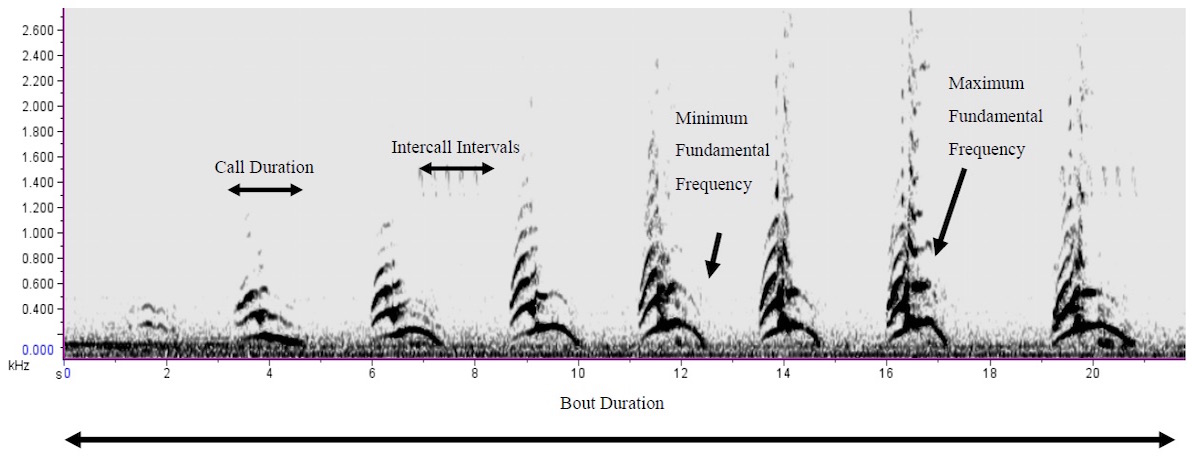Decoding a Tiger's Chuffs, Roars, and Groans
Could tigers’ vocalizations help to save the species?

Photos courtesy of Emily Ferlemann
In 2008, Courtney Dunn was an intern at the National Tiger Sanctuary in Chestnutridge, Missouri, where she gave educational tours, taught visitors about the plight of big cats in the wild, and bonded with a Bengal tiger named Tina. “Tina came from Texas, where someone had her as a pet,” Dunn says. “Oddly, enough, there are more tigers in the state of Texas alone than there are anywhere in the wild.”
Decades of hunting, habitat destruction, and poaching have decimated tiger populations worldwide, and according to the World Wildlife Foundation, only about 3,890 wild tigers remain. Three tiger subspecies—the Javan, the Bali, and the Caspian tiger—have completely vanished.
After working with Tina for some time, Dunn noticed that the big cat’s vocalizations sounded different based on whether the animal was communicating with other tigers or with her, and she began to wonder what other information a tiger’s vocalizations might reveal.
Dunn started recording and analyzing the calls of the sanctuary’s tigers, and made some interesting discoveries—for example, that tigers communicate with each other by making a sound similar to a cow’s moo. “It’s probably the closest thing a tiger has to a meow, but it just sounds very deep, as tigers are obviously much larger animals,” Dunn says. She also found that to greet one another (or their human keepers), tigers make a special noise called a prusten, or chuff, by keeping their mouths closed while pushing air through their nostrils. And, she was amazed to see that on a spectrogram, tigers’ vocalizations actually look just like tiger stripes. Her research led her to hypothesize that tiger groans, chuffs, and roars were unique enough to individual animals that they could be used to identify and count tigers in a given population, as well as impart other important information.
 In 2016, Dunn, now a zoologist at the Dallas World Aquarium, started the nonprofit The Prusten Project. She sent her research to Think for Tigers, an Oxford-funded organization that was scouring the globe for innovative ideas, products, and solutions that might help researchers and rangers locate, track, and monitor the dwindling population of tigers in the wild. With scientists from the University of Oxford WildCRU and staff members from World Animal Protection, Dunn spent 10 days in India at the Pench Tiger Reserve. It was her first time observing tigers in the wild. The team looked for pawprints in the dirt and followed them with their jeep. “The forests aren’t the way people often picture jungles with tigers. They’re usually dry with a lot of tall grass and thinned out patches of tree,” she says. So when prey animals, like Sambar deer or Langur monkeys, “called ‘tiger! tiger!’ we’d follow that sound until we reached one.”
In 2016, Dunn, now a zoologist at the Dallas World Aquarium, started the nonprofit The Prusten Project. She sent her research to Think for Tigers, an Oxford-funded organization that was scouring the globe for innovative ideas, products, and solutions that might help researchers and rangers locate, track, and monitor the dwindling population of tigers in the wild. With scientists from the University of Oxford WildCRU and staff members from World Animal Protection, Dunn spent 10 days in India at the Pench Tiger Reserve. It was her first time observing tigers in the wild. The team looked for pawprints in the dirt and followed them with their jeep. “The forests aren’t the way people often picture jungles with tigers. They’re usually dry with a lot of tall grass and thinned out patches of tree,” she says. So when prey animals, like Sambar deer or Langur monkeys, “called ‘tiger! tiger!’ we’d follow that sound until we reached one.”
Once Dunn was back in the states, The Prusten Project teamed up with 21 zoos and animal sanctuaries. They placed song-meters—tiny green boxes powered by D-sized batteries and four memory cards—in the enclosures of captive bengal, sumatran, malayan, and amur tigers to record their 27-29 second long calls, which researchers found to convey the most important data. Recordings cover a 144-hour period and are sifted through and deciphered by researchers and volunteers using Raven Pro, sound analysis software developed by the Cornell Lab of Ornithology in Ithaca, New York.
The results so far? Just by listening to a tiger’s long call, Dunn says, scientists can determine the animal’s age, weight, and sex with a 97 percent accuracy.
“Our research is revolutionizing the way tigers are studied and protected,” Dunn says.
In the field, song-meters could help researchers determine important information like whether there’s a healthy breeding population—tigers reach sexual maturity at three to six years of age. And if a big cat goes missing, researchers can dig into the sound-meter’s data to find out when and where it was last spotted, and even what time of day it was, based on the sounds of diurnal or nocturnal animals.

Tracking tigers by their vocalizations could help researchers avoid the pitfalls of traditional tracking methods. Tigers have 32-square-mile territories—a big chunk of land to scour for footprints or other signs of the big cats. If researchers rely on visual cues alone, there’s a good chance that they’ll count an individual twice. Camera traps, with their bright flash, can also be problematic. Poachers, who sell tiger parts on the black market can easily find and steal them. Sound-meters “blend in really well with the landscape,” Emily Ferlemann, The Prusten Project’s Director of Research says. And they can even help park rangers and law enforcement detect the presence of poachers. “They don't have any sort of indicator, and they're constantly recording.”
The team is also examining whether tiger vocalizations can be used to establish family lineage by placing sound meters in the enclosures of an extended family of tigers in zoos scattered around the USA—the family's matriarch, Mai, was a three-legged, Malayan tiger that lived at the Omaha Zoo. Research suggests that male tigers willingly share their prey with female tigers that have had their cubs, related males, and—as long as they recognize their scents—even males that have been in the area before. Are tigers simply sniffing out pheromones, or are they hearing a family-specific call? If sound bites can connect a family’s lineage, Ferlemann says, it could have major implications for conservation efforts in zoos and in the wild.
Click here to listen to some of the Prusten Project’s recordings.
 The Magazine of The Sierra Club
The Magazine of The Sierra Club



